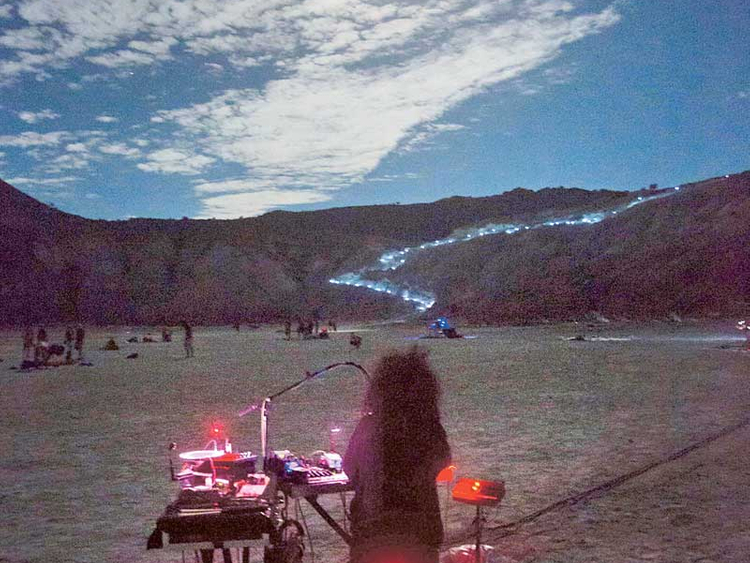NISYROS, Greece
The otherworldly landscape of central Nisyros, a jumble of looming caldera ridges and shimmering craters where fumaroles spit hot, sulphurous gases from the earth’s crust, is usually visited only by volcanologists and curious tourists.
But at dusk Thursday, 15 musicians gathered at an active volcanic crater on this small island in the southern Aegean Sea for an experiment in improvisational site-specific performance. Lit by a glowing August full moon, they played for 10 1/2 hours, asked only to take inspiration from their surroundings.
Titled “634 Minutes Inside a Volcano,” the event was organised by six d.o.g.s, an Athens arts space, and the Onassis Cultural Center. The musicians, mostly Greek and in their 20s and 30s, came from improvisational backgrounds, including jazz, classical, avant-garde and electronic, and many met for the first time at the sound check. Their instruments included electric guitar, piano, clarinet and synthesizer, as well as sample loops, and traditional eastern Mediterranean instruments such as the oud and the kanonaki.
For the performance, they were spaced around a large circle within the Stefanos Crater, which at nearly 1,000 feet in diameter is one of the largest active hydrothermal craters in the world. Each musician was hooked up to a center-facing amplifier, which fed into a 16-channel mixing board, all powered by a generator. In-ear monitors let each musician hear the others, as well as an engineered mix.
The result was an immersive layering of experimental, otherworldly soundscapes, evocative one minute of Sun Ra, the next of Aphex Twin or Autechre. Glitch and drone melded with desert-blown free jazz. Mournful loops of electrified cello overlaid throbbing synthesizer, the music constantly spinning apart and reassembling into a whole.
The organisers documented the event with photographs and an audio recording, which they plan to release in coming months. No artificial lighting was used inside the crater, so aside from the very beginning and end, when there was sunlight, the performance could not be captured by cell phone cameras.
“I wanted it to be such a raw and primitive experience that no documentation can capture it,” said Konstantinos Dagritzikos, the event’s 34-year-old artistic director and mastermind, who owns and runs six d.o.g.s, in Athens.
Dagritzikos began coming to Nisyros a few years ago and was entranced by the island’s volcanic terrain, which attracts up to 500 visitors a day in high season, many from Kos, the popular beach-holiday island to the north.
“It’s completely unique, basically the closest you can get to the center of the earth,” Dagritzikos said. “And if you realise where you are, that around those walls lava erupted 20,000 years ago and this whole island was created, it’s just mind-blowing.”
Nisyros is part of the South Aegean Arc, a line of active volcanic centers that stretches from the Saronic Gulf opposite Athens to the Bodrum Peninsula in southwest Turkey. The Nisyros caldera is one of the more active parts of this formation, with high tectonic activity recorded in recent years.
Hostile environment
The hostility of the environment was a major appeal for Dagritzikos, as was the fact that the island is small, minimally developed and remote. It takes about 14 hours to reach Nisyros by ferry from Piraeus, Greece.
“I like to play with time and challenge,” he said. “Our whole lives are just a click. That’s why I like to challenge people to actually think about what they’re experiencing.”
Dagritzikos found a partner in the Onassis Cultural Center, a privately funded foundation started in 2010 by the estate of the Greek shipping magnate Aristotle Onassis.
Dagritzikos spent months assembling the ensemble and consulting with volcanologists about safety and logistical measures. At their recommendation, the most active parts of the crater were cordoned off, and the organisers installed safety rails, a first-aid tent and low-wattage LED lighting on the path leading down to the crater. Signs advised people not to stay in the crater for more than 60 minutes at a time, as inhaling the sulphur fumes could carry health risks, including headaches and nausea. (Many of the musicians took breaks, individually, for the same reason.)
The performance began at 7:58pm Thursday and finished at 6:32am Friday. About 2,000 visitors — double the permanent population of Nisyros — streamed in throughout the night, a mix of locals, tourists still in beachwear, and denizens of the Athens arts and media scenes.
Starting at dusk, some visitors lined up along the crater’s outer edge, casting black silhouettes across the darkening blue sky. Others hiked down into the crater, sitting or lying in the center of the circle or walking around the circumference, from musician to musician, effectively creating their own simultaneous mix by moving toward and away from various musicians. Some wrapped their heads in scarves to protect themselves from the thick, sulphurous air.
Outside the crater, vendors sold grilled souvlaki and corn on the cob. A festive crowd flanked the concession stand throughout the night, drinking beer and raki.
“That’s Greece, the whole situation upstairs, everyone drinking and talking and eating souvlaki, and then under them this pagan ritual,” Dagritzikos said.
At 10pm, the moon rose over the edge of the crater, drenching it in white light as the music built in intensity. Around midnight, the fumaroles around the inner edge of the crater began to release jets of sulphurous gases into the air. The musicians took intermittent breaks, with all rejoining for a climactic ending as the sun rose over the island.
— New York Times News Service













